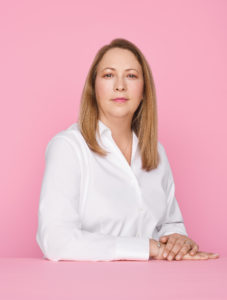A divorce is a harrowing life experience. It’s also confusing and expensive. A marriage, after all, is a legal contract that affects everything from real estate to bank loans to child custody. And so, unsurprisingly, the task of dissolving that contract is a bureaucratic nightmare.
At every turn, there is a new form: to initiate divorce proceedings, to make changes to an agreed-upon settlement or to disclose information about financial status and assets. And, of course, these forms are freighted with long-winded legalese.

“I don’t want to be a legal disruptor. I want to empower people,” says Kathryn Hendrikx.
“In the hands of a regular person, they are overwhelming,” says Kathryn Hendrikx, principal of the sole proprietorship Hendrikx Family Law. “You just don’t know where to look.” You could hire a lawyer, but the initial retainer, which includes the first round of paperwork, can cost upwards of $5,000. That’s a travesty.
Hendrikx has come up with a solution. In 2015, she was filling out her tax return using TurboTax — the popular software program that saves Canadians hundreds of millions on accountants’ fees — and she had a thought: Why isn’t there a similar product for people getting divorced? They could log in to a secure website and answer a series of questions in plain English. At the end, the software would spit out a set of completed forms, such as an application to commence proceedings or an affidavit of custody if children are involved. These could then be presented in court. One year later, Hendrikx met with a computer programmer. Over 18 months, the duo built the Ontario Family Law Forms Project, a user-friendly web application that guides clients, step by step, through the entire paperwork process.
The family-law system is in a state of crisis. Across Canada, 64 percent of family-law litigants are self-represented. And at the busiest courthouses in Toronto, that number can reach up to 74 percent. Most of these people retained a lawyer for the initial phase of their divorce but couldn’t afford the ever-growing fees. In other words, they blew their money on paperwork. If they could handle their own forms, they could redirect their legal budgets to other kinds of services: legal coaching, dispute resolution or courtroom advocacy. “I don’t want to be a legal disruptor,” says Hendrikx. “I want to empower people.”
When the product goes to market, it will cost less than $200 to use. Right now, it’s in beta form. Many people have tested it, though, including the University of Windsor’s legal clinic, as well as Hendrikx’s colleagues and clients.
One such person is Diana Campbell, a public-health worker, who, in 2015, separated from her husband of two years. Because of a protracted custody battle, she has spent $76,000 on legal fees. After testing Hendrikx’s software, she realized that, had the product been available throughout her divorce, it would have saved her tens of thousands of dollars. “I’d definitely still need a lawyer,” she says. “But it would be nice to have some money left in the bank to invest in my child.”
Don’t forget to read about our other Innovation Awards winners.
This story is from our Winter 2019 Issue.
Photography by Shalan and Paul, hair and makeup by Michelle Calleja.



